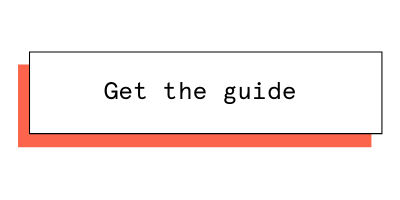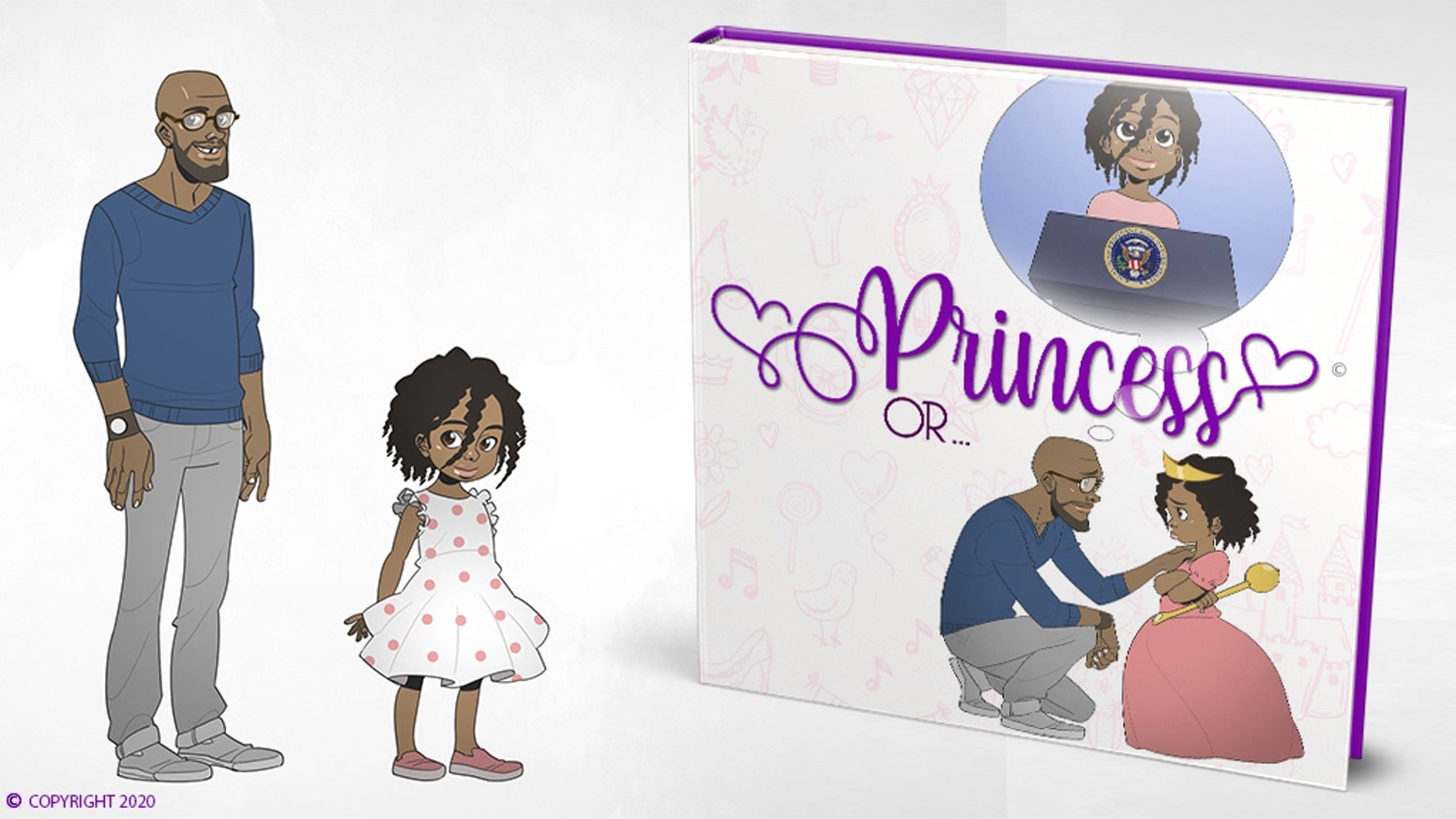Mario Waugh has worked as a graphic designer, app developer, and mobile website designer for years. But he always had an interest in writing. He decided to run a Kickstarter campaign to publish his first book — a children’s story called Princess Or… — in May 2020. Rooted in his relationship with his young daughter Marie and his desire to show her that there is more to life than being a princess, the project was a success. He raised $18,784 with 348 backers. However, Waugh was very close to not getting funded. Although he ultimately ended up surpassing his goal by almost $900, he primarily learned how to start a Kickstarter campaign on the fly.
As his campaign progressed, he saw that he could have taken steps to make reaching his goal less stressful. Here are a few of the lessons he learned and tips other first-time creators can use to optimize their campaigns.
Building a prototype
Sometimes there are tools or resources that you don’t realize you’ll need until you’ve launched. For Waugh, one of those tools was a printed proof or what could more generally be referred to as a prototype.
“I wish that I had finished the book, printed the book, and had a copy so that I had something that I could show, and say, ‘This is what I have, this is what I’m trying to do.’ That would’ve been beneficial,” Waugh says.
A prototype or preliminary version of your product isn’t a requirement to start a Kickstarter or Indiegogo campaign in every case. Some people even start a Kickstarter or Indiegogo campaign to fund the development of a prototype. But just because it isn’t technically required in every case, doesn’t mean that you shouldn’t have something more tangible to share with potential backers.
Why prototypes are important in crowdfunding
1. Generating hype: First — and perhaps most apparent — prototypes give backers and potential backers a sense of what they’ll be receiving from you. Offering up that first look can entice prospects and excite the backers you already have.
2. Prototypes help build trust. You want to be as transparent as you can about what you’re delivering. And while there may be some changes as you move through the development and manufacturing or publishing process, backers should have a good idea of what they can expect from you.
3. Collaborating with your community. Your backers are invested in your success — they want you to do well! When you share your prototype with your community, they can offer feedback to improve the final product.
4. Get third-party reviewers. Before you start a Kickstarter or Indiegogo campaign, you can send your working prototype to reviewers to get feedback. You can also use these unbiased quotes on your Indiegogo or Kickstarter campaign page to boost your credibility. Make sure to give the reviewers a deadline that is at least a few weeks before you launch, so you can get your page ready.
For a book project like Princess Or…, you could have a completed copy of the book or share a few mockups of the pages to show the illustration and writing style. Technology and design projects should show the product in action, highlighting specific features, how it functions, and everyday applications.
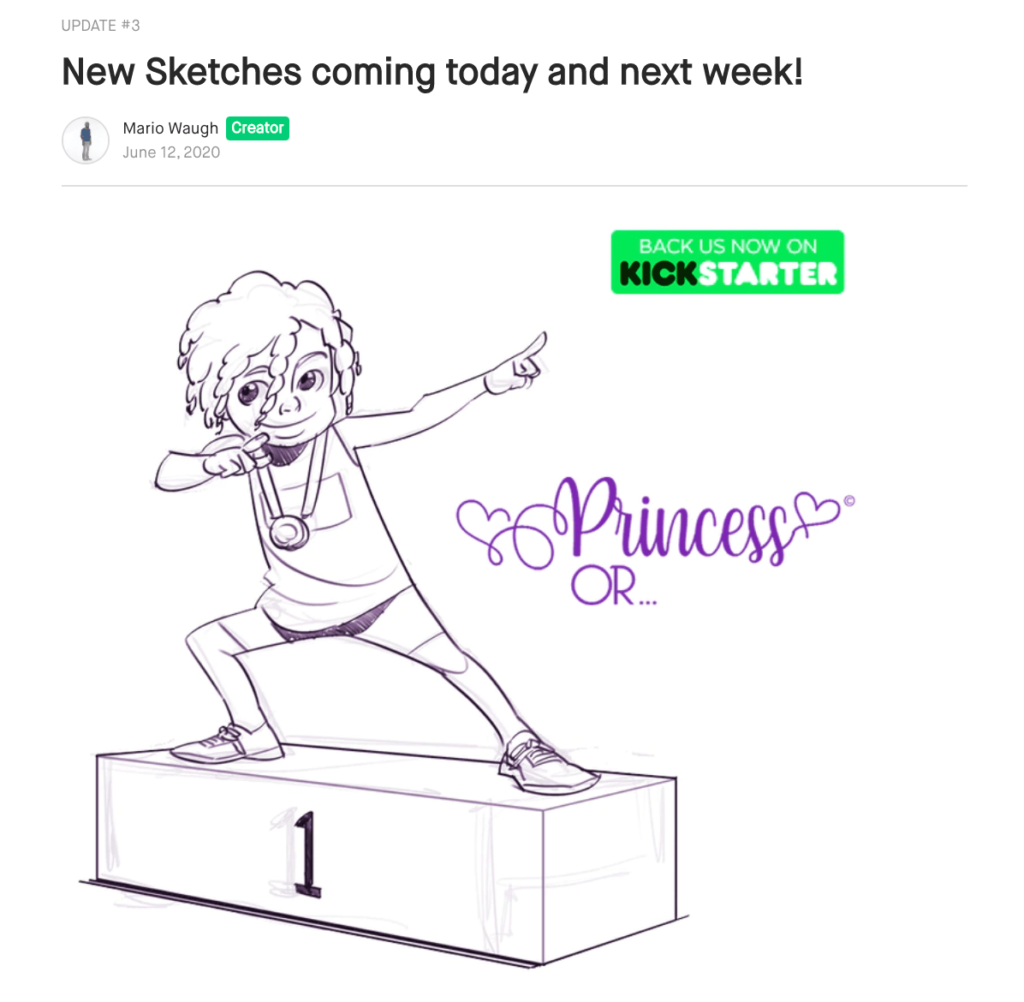
Whether you create a demo video, a product trailer, or share high-quality images, clearly showing what backers will be getting from you will only help your campaign. But all isn’t lost if you’ve launched without a prototype. Although Waugh didn’t have a finished copy, he was sure to share illustrations in his campaign updates to give backers a taste of the final book.
Pre-launch promotion and building an online presence
During his campaign, Waugh worked hard to spread the word about his project. “I was using Facebook Ads, Instagram Ads — we were running ads all the time. I was spending hours working on it,” he says. Ads can be an excellent way to promote a crowdfunding project. However, they are most powerful when you’ve also done promotional work pre-launch.
This is exactly what Waugh realized after he launched. “I should have established an online presence for the business first. I should have been tweeting about the book, tweeting about the upcoming Kickstarter, and getting everybody ready for the Kickstarter launch. That’s something that’s very important,” Waugh says.
How to start a wave of support for your Kickstarter campaign
The first 48 hours of a campaign can give creators the early push they need to reach their funding goal. Getting a significant number of pledges in that time boosts your visibility on Kickstarter and helps build your campaign’s momentum. The best way to get those early pledges — and set yourself up for success when you use ads later in your campaign — is by mobilizing your community and building your audience before you launch. A few ways that you can do this include:
Building a landing page or website: Include a description of your project and its backstory, and an email address submission form to collect contacts and build your community. Put a link to your site at the top of your social media profiles and in your email signature to get more eyes on it. You can easily create a landing page using BackerKit Launch to capture email leads before you launch your campaign.
Kickstarter Pre-launch Page: If you’re using Kickstarter, direct people to your pre-launch page, and they can get essential information about your project and choose to be notified when you launch.
Sending pre-launch emails: After you’ve built your email list, send messages to your community, preparing them for launch day, and stressing the importance of pledging early.
Join online communities: Be on the lookout for Facebook groups and other online communities that have some connection to your product or crowdfunding in general. Post links to your website and share your concept when it’s relevant to the conversation.
Social media blasts: Get people hyped for your campaign by posting to the major social platforms in the weeks leading up to your campaign. Share project photos, videos, and behind-the-scenes content. Encourage them to repost your updates to their followers.
In addition to promoting your campaign, you should also introduce Kickstarter or Indiegogo to your audience. Some people who are interested in your project may not be familiar with crowdfunding. Let everyone know how your chosen platform works. How do they sign up for an account? How do they pledge? When should they pledge? Make sure you answer these questions for them, so they’re prepared when you launch your campaign.
Setting up reward tiers
Whether you’re a first-time creator or more experienced, setting reward tiers is challenging. For Waugh, the difficulty wasn’t just figuring out what would entice backers; he also didn’t know what backers expected to see and receive from projects like his.
“I had to kind of change the rewards and individually edit the rewards because I just didn’t know how to set them up,” he says. “For example, there were people who gave $500, and they were like ‘so, I only get one book?’ And I was like, ‘how many do you want?’ The tiers should’ve been more specific.”
Your rewards are your chance to thank your backers for their support. Some people are happy to contribute just because they believe in your idea, but most expect to receive something of value for their pledge. You should offer a copy of your work or the product you’ve created as a reward. But at the higher pledge levels, you should be adding extra value.
One obvious way to increase the value is to offer additional copies. Waugh decided to add digital copies to pledge levels, which his backers loved. Other options include exclusive artwork, putting backers’ names on a “thank you” page, collector’s editions, enamel pins, or other small souvenirs.
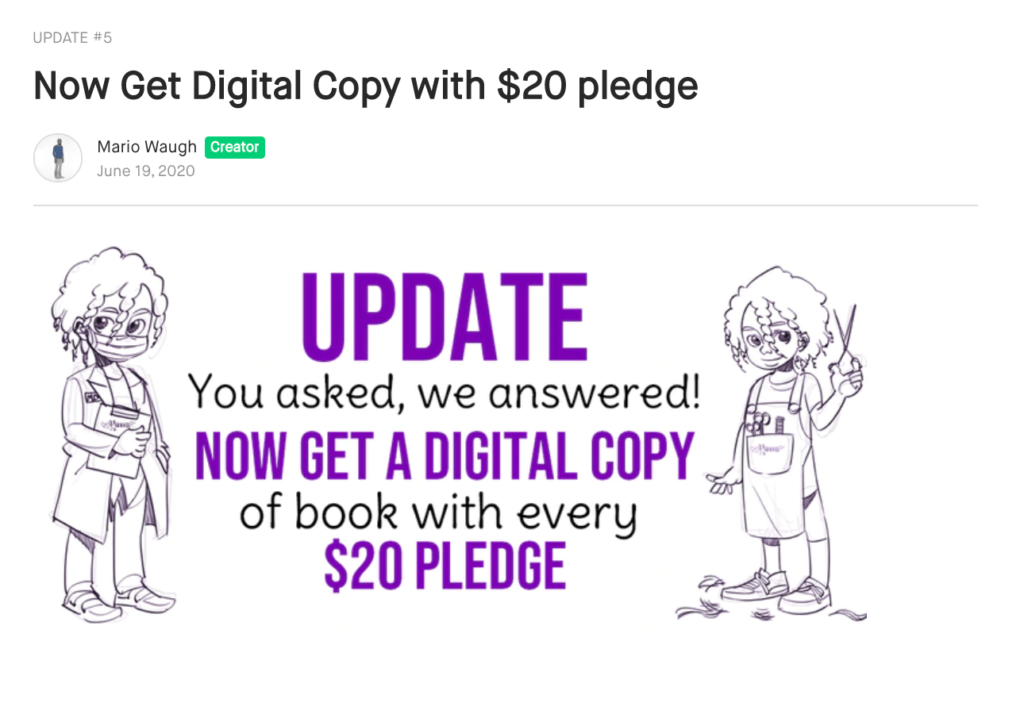
When you’re ready to start building your rewards, keep the following guidelines in mind:
1. Price your product: When you know the price of your product, you’ll be able to ensure that the cost of producing and delivering the reward doesn’t leave you in the red.
2. Have a variety of rewards: Include rewards at different price points to allow anyone who is interested — regardless of their financial background — to contribute. Remember to include an introductory one-dollar pledge level, which can help attract more backers.
3. Be unique: Why would someone pledge $25 when the reward at the five-dollar level isn’t significantly different? Incentives offered at each reward level should be unique.
4. Limit reward levels: Not having enough reward tiers could stop you from getting the funds you need. But too many reward tiers can confuse backers and make fulfillment a nightmare. Striking the right balance isn’t easy. But think hard about what you’ll be able to realistically handle post-campaign. Also, look at what similar projects are doing and choose a number that is roughly the same.
How to start a Kickstarter campaign: Pursuing your passion and finding fans
Although there were bumps along the road, there were two aspects of the Princess Or… campaign that went particularly well for Waugh: idea validation and finding fans willing to promote the project
Developing a strong concept
The idea for Princess Or…was born during a conversation with a friend of Waugh’s, who also has a young daughter. “We were talking about how we love that our daughters are princesses, but it would be really great if they would also think about more than that,” Waugh says. After that first conversation, he was so inspired that he sat down in one weekend and wrote the whole book. Everyone he shared it with loved it.
While the book was a hit within his network of friends and family, Waugh wanted to test the idea out on a larger scale. Kickstarter seemed like the perfect venue. “Kickstarter gave me the opportunity to see how many people liked the idea and how much support I would get. It’s not only fundraising, it’s also a test group,” Waugh says.
Throughout the campaign, he consistently received feedback from backers about how much his concept resonated with them. Starting with a personal idea, as Waugh did, can lead you to something that has universal appeal.
Finding an idea you’re passionate about before you start a Kickstarter campaign
Instead of trying to think of some extraordinary, million-dollar idea that will solve everyone’s problems, think about something that you would love to see in the world. What is something that would personally make you excited or help you in your daily life? What is an issue that you’re struggling with? We’re all humans, so it’s almost certain that someone else is also dealing with the same issues or has the same interest.
Also, coming up with personal projects is just going to be more fun for you to work on. The passion you have for your project will motivate you to do good work and give you the strength to face the challenges you’re bound to encounter. So, when developing an idea, remember to look inward rather than trying to guess what other people might like.
Connecting with project advocates and promoters
Waugh noticed spikes in his pledges after his project was featured in BackerKit’s newsletter and selected as a “Project We Love” by Kickstarter. Getting this kind of traction wasn’t planned. In fact, it came during an unprecedented and difficult time.
Waugh’s campaign happened to be running during the summer of 2020 — a period when the U.S. was reckoning with its treatment of Black Americans, systemic racism, and the opportunities that are open to the Black community. During this time, BackerKit and many other members of the crowdfunding community began looking for ways to better support Black creators. One of those ways was to simply bring attention to projects by Black Creators like Waugh that were inspiring, entertaining, or simply cool.
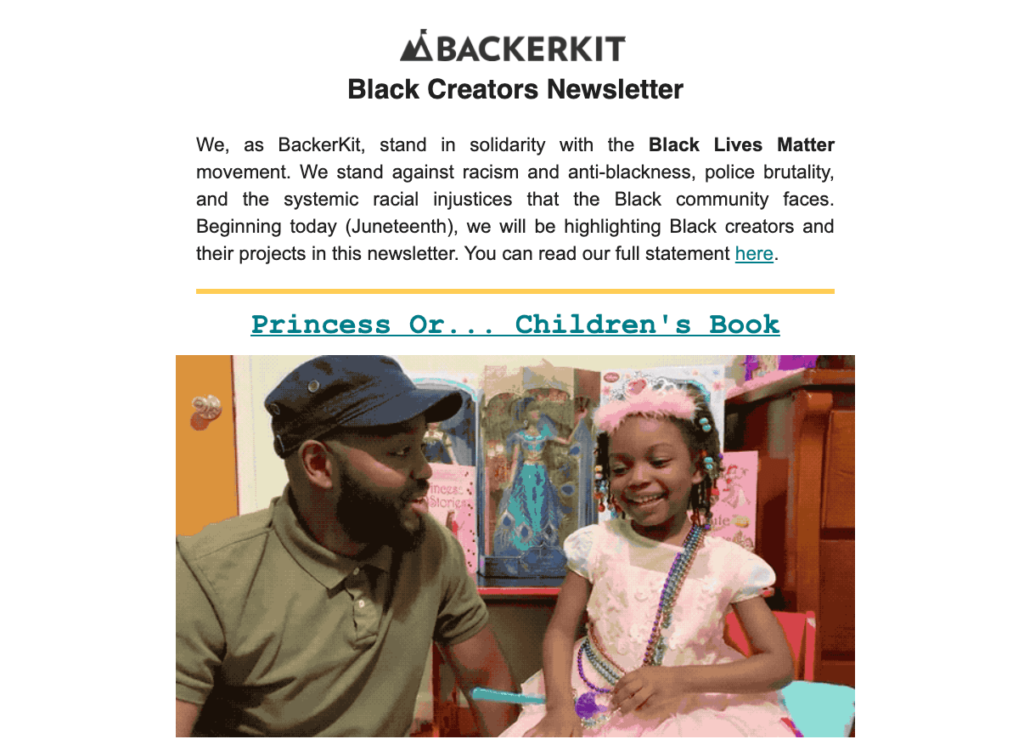
Waugh never courted this kind of exposure. His project was in development long before he received this attention. But that additional promotion did help him reach his goal.
This turn of events demonstrates how important it is to have advocates and, again, how important it is to have a strong concept. Good ideas can get buried in the sea of projects that are out there. Having someone who loves your idea and can use their platform to get the word out about your campaign is a huge benefit to first-time creators who haven’t made a name for themselves yet.
Moving the odds in your favor
Sometimes your project will be selected for a feature. But when it’s not, you can and should create that opportunity for yourself. Here are just a few ways that you can get influential people in your community to introduce your product to their audiences:
Partner with other creators: Don’t be afraid to build your network. Join online crowdfunding communities, go to online and in-person conventions, and seek out creators on Indiegogo or Kickstarter that target an audience similar to yours but aren’t competitors. Partner with them. Ask them to post your campaign link on their website, social, in their campaign updates on Kickstarter or Indiegogo, and in email marketing messages.
Reach out to influential people in your community: Is there a creator in your category you admire? What about an influencer whose content aligns with your project? Send them a DM or email, sharing your project, your story, and perhaps offering to give them a test copy or version of what you’ve created.
Contact bloggers and online publications that publish content that’s relevant to your project: Before you start developing a public relations strategy for your Kickstarter campaign, do your research. Who is writing about topics that your target audience would be interested in? Connect with them and see if they’d be interested in writing an article about your project or letting you write a guest post.
Follow your crowdfunding platform’s guidelines: If you’re hoping to get featured, make sure that your campaign page follows your chosen platform’s best practices and recommendations. Kickstarter has an entire article on how they choose campaigns for their “Projects We Love” feature. Once you’ve done that, take a look at the campaign pages of other projects that have been featured. What are they doing? What can you replicate and make work for your campaign page?
Basically, it all boils down to sharing your project with as many people as possible and making genuine connections with them. If you’re starting with a strong, compelling idea, you will be able to find people that are happy to promote your work. But don’t give up if some people say “no.” You owe it to yourself and your project to build your network.
As prepared as you are, there will always be lessons you’ll learn while you’re in the middle of your campaign or even afterward, when you start to manufacture your product. Some of those lessons will come from the challenges you face, some from the moments you’re successful. The top crowdfunding creators repeat, optimize, and build on those wins for their future projects. In this way, they can design a campaign roadmap.
Waugh is currently publishing Princess Or… and getting ready for fulfillment and shipping. He’s also already mentally preparing to take what he’s learned and start a second Kickstarter campaign. He hopes to write a comic book. Despite a few difficulties during this first campaign, he had a positive crowdfunding experience.
“Every day was very exciting, and I was nervous every day,” he says. “It was exciting just seeing that bar go up and knowing that you’re getting closer to your goal. Knowing that it’s attainable. Knowing that there are other people who like your idea and that they’re willing to support it.”
BackerKit sends out a Black Creators Newsletter twice a month. If you are a Black crowdfunding creator or know of someone you’d like to see featured, please reach out to [email protected].
As you can see from Waugh’s journey, there’s so much you need to accomplish before starting a crowdfunding campaign — from developing a prototype and building a community to setting up reward tiers. To learn the right way to start a Kickstarter or Indiegogo campaign and set yourself up for success during fulfillment, check out our guide, Pre-Launch Do’s and Don’ts. 